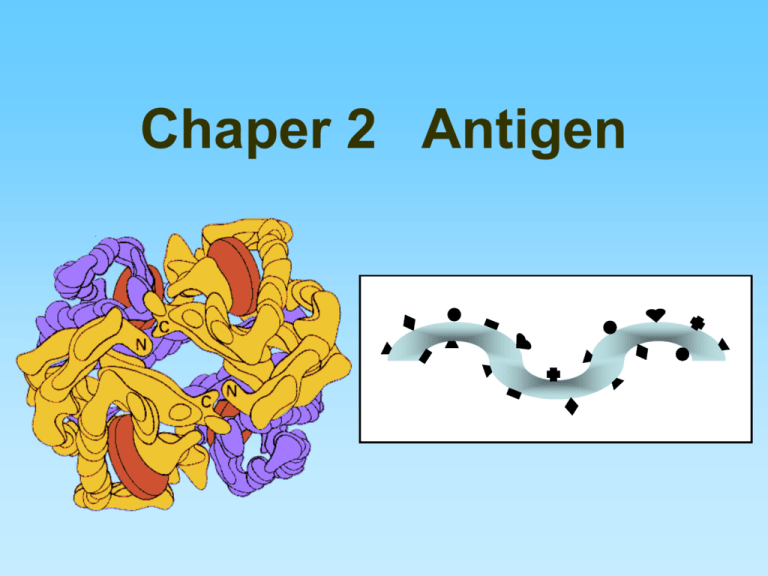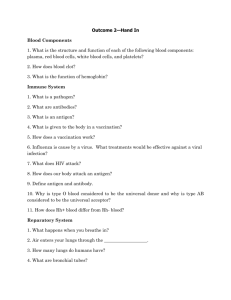Chapter 2 Antigen
advertisement

Chaper 2 Antigen Pathogen-associated molecule pattern 病原体相关模式分子 Avian influenza virus Foot-and-mouth disease virus Molecule pattern of Gram negative bacteria 革兰氏阴性细菌表面模式分子 Toll-like receptor, TLR Innate immune system recognizes “danger signals” Why is an DNA molecule, Or, RNA molecule called antigen? 2.1 Concept of Antigen • Antigens are substances that induce a specific immune response and subsequently react with the products of a specific immune response. 抗原是能够刺激机体免疫系统产生特异性免疫应 答、并能与相应免疫应答产物(抗体或致敏淋巴 细胞)在体内外发生特异性结合的物质,也叫免 疫原(immunogen)。 • An antigen is a molecule that stimulates an immune response. • The word, antigen, originated from the notion that they can stimulate antibody generation. We now know that the immune system does not only consist of antibodies. • The modern definition encompasses all substances that can be recognized by the adaptive immune system(i.e. T cell & B cell). • Tolerogen - An antigen that invokes a specific immune non-responsiveness due to its molecular form. If its molecular form is changed, a tolerogen can become an immunogen. • Allergen - An allergen is a substance that causes the allergic reaction. The (detrimental) reaction may result after exposure via ingestion, inhalation, injection or contact with skin. Antigens can be classified in order of their origins • Exogenous antigens Exogenous antigens are antigens that have entered the body from the outside, for example by inhalation, ingestion, or injection. By endocytosis or phagocytosis, these antigens are taken into the antigenpresenting cells (APCs) and processed into fragments. • Endogenous antigens Endogenous antigens are antigens that have been generated within the cell, as a result of normal cell metabolism, or because of viral or intracellular bacterial infection. • Autoantigens An autoantigen is usually a normal protein or complex of proteins (and sometimes DNA or RNA) that is recognized by the immune system of animals suffering from a specific autoimmune disease. These antigens should under normal conditions not be the target of the immune system, but due to mainly genetic and environmental factors the normal immunological tolerance for such an antigen has been lost in these animals. • Tumor antigens Tumor antigens are those antigens that are presented by the MHC I molecules on the surface of tumor cells. These antigens can sometimes be presented only by tumor cells and never by the normal cells. In this case, they are called tumor-specific antigens (TSAs) and typically result from a tumor specific mutation. 2.2 Characteristics of Antigen 1. Immunogenicity 免疫原性 The capacity to stimulate the production of antibodies or cell-mediated immune responses. (1) (2) 2. Antigenicity 抗原性(反应原性) The ability to bind antibody. 3. Complete antigen 完全抗原 Antigen has both immunogenicity and antigenicity. 4. Incomplete antigen, also known as hapten 不完全抗原,或半抗原 Antigen has only antigenicity. Efficacy of carrier OVA:(鸡)卵白素 DNP:二硝基苯 BSA:牛血清白蛋白 Incomplete antigens have antigenic determinants, but cannot induce immune responses because they lack one or more of the important attributes needed for this function (one example of an incomplete antigen is a hapten, which is an artificial monovalent epitope) 2.3 Properties of antigen • Foreignness is essential to immunogenicity because self-responsive cells are eliminated during lymphocyte ontogeny, leaving only cells that respond to non-self, so-called "foreign" epitopes. 异物性 • Specificity 特异性 • High molecular weight Molecule of Hemoglobin 2.4 Antigenic epitopes Epitopes, or, Antigenic determinants, Are the portions of antigen molecules that physically interact with paratopes (combining sites) of immune response molecules and therefore actually "determine" antigen specificity. Three dimensional structure of M. tuberculosis antigen 85B 2.4.1 Antigenic epitopes 2.4.2 Types of Epitopes 1. Linear epitopes ♣ continuous and found in polysaccharides as well as in both native (nondenatured) and denatured proteins, especially fibrillar proteins. ♣ specificity depends upon primary sequence. ♣ typical size is 5-6 subunits in length. 2. Conformational epitopes ♣ Discontinuous (involve multiple subunits, often located far apart in the primary sequence of the antigen molecule) and are thus found only in native (globular) proteins. ♣ Specificity depends upon conformation, or three-dimensional shape, which is a combination of tertiary and quaternary structure supported by primary and secondary structures, of course. ♣ Typical size is hard to pinpoint, but sequences of up to 16 amino acids in certain protein antigens have been shown to interact with their complementary paratope. Two different epitopes • B cell epitope, a • T cell epitope, the portion of antigen region of antigen molecule that is molecules that are recognized by B cell recognized by T cell receptors(BCR). receptors(TCR). T cell epitope and B cell epitope 2.5 Classification of Antigens • Thymus-dependent antigen(TD-Ag) 胸腺依赖抗原 • Thymus-independent antigen(TI-Ag) 胸腺非依赖抗原 2.6 Superantigen 超抗原 • Molecules that are potent T lymphocyte mitogens and simultaneously bind to MHC-II molecules. They are often associated with staphylococcal products and are involved in enterotoxemia and toxic shock syndrome in humans. • Superantigens (SAgs) are secreted proteins (exotoxins) that exhibit highly potent lymphocyte-transforming (mitogenic) activity directed towards T lymphocytes. • Superantigens are not processed and interact with the MHC molecule outside of the peptide-binding groove. • Superantigens only bind to Vβ segment of TCR. TCR Conventional Ag • Compared to a normal antigen-induced T-cell response where 0.001-0.0001% of the body’s T-cells are activated, SAgs are capable of activating up to 20% of the body’s T-cells. This causes a massive immune response that is not specific to any particular epitope on the SAg. Superantigens Conventional Antigen Monoclonal/Oligoclonal T cell response 1:104 - 1:105 Superantigen Polyclonal T cell response 1:4 - 1:10 2.7 Mitogen 丝裂原 • An agent that induces mitosis. Here means to activate T cells and/or B cells without help from APCs. • Lectin, for example, concanavalin A (ConA). • LPS(lipopolysaccharide) • Staphylococcal protein A(SPA) 2.8 Adjuvant • Adjuvant: The Latin "adjuvans" means to help, particularly to reach a goal. • An adjuvant is a substance that helps and enhances the pharmacological effect of a drug or increases the ability of an antigen to stimulate the immune system. Classification of Adjuvant • Freund’s adjuvant ♥ Complete Freund’s adjuvant(CFA) ♥ Incomplete Freund’s adjuvant(IFA) • Liposome • Inorganic compound • Cytokine • Biodegradable nanoparticles Mechanisms of adjuvants • Prolonged persistence of immunogen molecules at the site of injection. • Enhancement of co-stimulatory signals. • Induction of granuloma formation. • Stimulation of lymphocyte proliferation in a non-specific manner. 2.9 Other antigens 9-1 Heterophilic antigen 异嗜性抗原 A kind of common antigen, existing in human, animals, and microbes. Fossman antigen. 9-2 Xenogenic antigen 异种抗原 This antigen comes from different genus and generic. For example, pathogenic antigen. 9-3 Allogenic antigen 同种异型抗原 The specific antigen exists in different individuals. Blood type antigens 9-4 Autoantigen 自身抗原 A pathological term. BUT, sperm antigen 9-5 Common antigen, or, cross-antigen 共同抗原,或交叉抗原 9-5 Idiotypic antigen 独特型抗原 An antibody molecule is some sort of foreign molecule when generated in animal body. Such that immune system recognizes it as Antigen, which is known as Idiotypic antigen. Thank you! Next Lecture: Antibody







